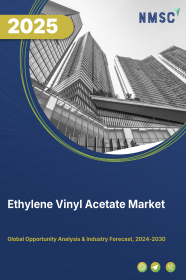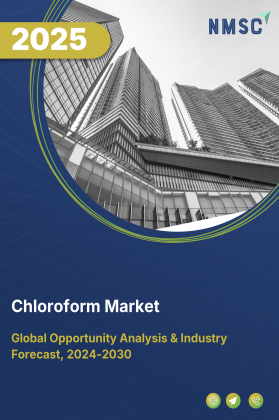
Ethylene Vinyl Acetate Market by Type (Low Density Ethylene Vinyl Acetate, Very Low-Density Ethylene Vinyl Acetate, High Density Ethylene Vinyl Acetate, and Medium Density Ethylene Vinyl Acetate), By Application (Hot Melt Adhesives, Photovoltaic Panels, Printing Ink, Extrusion Casting, Film, Wire & Cable, Solar Cell Encapsulation, Coatings, Plasters and Cement Renders, Injection Molding, Foam, and Others) – Global Opportunity Analysis and Industry Forecast, 2023 – 2030
Market Definition
The Ethylene Vinyl Acetate (EVA) Market size was valued at 12.20 billion in 2022 and is predicted to reach 18.98 billion by 2030 with a CAGR of 5.7% from 2023-2030.
Ethylene Vinyl Acetate is a copolymer composed of ethylene and vinyl acetate monomers. It is a versatile thermoplastic material with a wide range of applications due to its unique properties. EVA possesses attributes such as flexibility, transparency, low-temperature resistance, good impact strength, and compatibility with various additives and fillers. It finds extensive use in industries such as packaging, footwear, automotive, electronics, and sportswear, where its combination of elasticity, toughness, and processability contributes to its utility in creating diverse products ranging from flexible films and foam materials to adhesives and coatings.
Market Dynamics and Trends
The growing demand for EVA in packaging materials is driven by its excellent clarity, flexibility, and low-temperature sealing properties. As the packaging industry evolves and the need for customized packaging solutions increases, EVA is well-positioned to meet these demands, which is driving market growth.
In addition, the global surge in solar PV installations is driving the demand for EVA, which is used as an encapsulant in solar panels and is boosting the growth of the EVA market. According to International Energy Agency, in 2022, solar PV generation grew by a massive 26% in 2023, reaching an impressive 1,299 TWh. This was the largest absolute growth of any renewable energy source, surpassing wind power for the first time.
However, the emergence of Low -Density Polythene (LDPE) as a substitute of EVA is expected to restrain the growth of market during the forecast period.
On the contrary, the launch of new shoes and clogs made with biobased EVA polymers, which are more sustainable than traditional EVA polymers, is expected to boost the growth of the ethylene vinyl acetate (EVA) market.
For instance, in February 2021, Braskem, the world's leading producer of biopolymers, launched a new line of EVA clogs made from 50% of its I'm green bio-based EVA. The clogs offer the same features of a conventional resin, such as flexibility, lightness, and resistance, while also being more sustainable. This is expected to create significant growth opportunities for the market in the coming years.
Market Segmentations and Scope of the Study
The ethylene vinyl acetate market is segmented on the basis of type, application, end user industry and region. On the basis of type, the market is categorized into low density ethylene vinyl acetate, very low-density ethylene vinyl acetate, high density ethylene vinyl acetate, and medium density ethylene vinyl acetate.
On the basis of application, the market is divided into hot melt adhesives, photovoltaic panels, printing ink, extrusion casting, film, wire & cable, solar cell encapsulation, coatings, plasters and cement renders, injection molding, foam, and others.
On the basis of end user industry, the market is divided into building & construction, packaging, pharmaceutical, agriculture, automotive, and others. Geographic breakdown and analysis of each of the aforesaid segments includes regions comprising North America, Europe, Asia-Pacific, and Rest of World (RoW)
Geographical Analysis
Asia-Pacific holds the predominant share of ethylene vinyl acetate market at present and is expected to continue its dominance during the forecast period. This is attributed to the factors such as the introduction of EVA footwear in the region by various footwear company, as well as the expansion of collaborations and product launches.
For instance, in July 2022, Metro Brands, a leading footwear retailer in India, partnered with Biion, a Canadian footwear company, to bring Biion's versatile collection of EVA shoes to the Indian market. The company specializes in making lightweight, comfortable, and highly functional shoes using EVA material. Through this collaboration, there has been a growing demand for EVA footwear solutions that provide comfort and convenience for people with active lifestyles.
In addition, the increasing demand for EVA in solar panels is driving the market growth, as companies are working to introduce this material into more applications. For instance, in October 2022, Hyundai Chemical and Lotte Chemical jointly completed the construction of USD 2.1 billion heavy-feed petrochemical complex (HPC) in Daesan, South Korea. The HPC is designed to produce 850,000 tons of ethylene and 500,000 tons of propylene per year. These products will be used to make a variety of plastics, including polyethylene, polypropylene, and EVA. This EVA is further used in solar panels, footwear, and other applications.
On the other hand, North America is expected to show a steady rise in the market due to rising installation of solar panels in the region. According to the U.S. Energy Information Administration (EIA), the U.S. installed a record 13.2 GW of utility-scale solar capacity in 2021, up 25% from the previous year. The average value of panel shipments also fell from USD 1.96 per peak kW in 2010 to USD 0.34 per peak kW in 2021, indicating a significant decline in solar panel prices. This makes solar panels more affordable and accessible, driving demand for EVA in the region.
Moreover, the increasing use of EVA in the automotive sector for a variety of applications, such as soundproofing, interior components, seals, adhesives, and insulation, is driving the demand for EVA in the region. For instance, the U.S. is the world's second-largest market for vehicle sales and production, with light vehicle sales of 14.5 million units in 2020. This large market for vehicles drives the demand for EVA, which is used in a variety of automotive applications, such as soundproofing, interior components, seals, adhesives, and insulation.
Competitive Landscape
The EVA market comprises of various market players such as Arkema S.A., Sipchem, Braskem S.A, Lyondellbasell Industries, Celanese Corporation, Dow Inc., Exxon Mobil Corporation, Hanwha Chemical Corporation, Formosa Plastics Corporation, Al Habib Polymers Fze, and others.
These market players are adopting various strategies such as collaboration across various regions to maintain their dominance in the EVA market. For instances, in May 2022, Braskem, the largest polyolefins producer in the Americas, announced plans to supply Welli Bins with additional quantities of its I'm greenTM carbon-negative EVA biopolymer. Welli Bins are the first planet-friendly storage and organization solution made from plant-based, washable, durable, and sugarcane-based materials. This move is intended to support the increased production of Welli Bins, which are sustainable storage bins.
In addition, April 2021, LyondellBasell announced that Shandong Yulong Petrochemical Co. Ltd has licensed its high-pressure polyethylene technology for two new production lines at its facility. The first line will produce 200 kilotons per annum (KTA) of low-density polyethylene (LDPE), and the second line will produce 300 KTA of LDPE and EVA. The EVA line will use the vinyl acetate comonomer to produce LDPE with improved properties.
Key Benefits
-
The report provides quantitative analysis and estimations of the ethylene vinyl acetate market from 2023 to 2030, which assists in identifying the prevailing market opportunities.
-
The study comprises a deep-dive analysis of the ethylene vinyl acetate market including the current and future trends to depict prevalent investment pockets in the market.
-
Information related to key drivers, restraints, and opportunities and their impact on the ethylene vinyl acetate market is provided in the report.
-
Competitive analysis of the players, along with their market share is provided in the report.
-
SWOT analysis and Porters Five Forces model is elaborated in the study.
-
Value chain analysis in the market study provides a clear picture of roles of stakeholders.
Key Market Segments
By Type
-
Low density ethylene vinyl acetate
-
Very low-density ethylene vinyl acetate
-
High density ethylene vinyl acetate
-
Medium density ethylene vinyl acetate
By Application
-
Hot Melt Adhesives
-
Photovoltaic panels
-
Printing Ink
-
Extrusion Casting
-
Film
-
Wire & Cable
-
Solar Cell Encapsulation
-
Coatings
-
Plasters and Cement Renders
-
Injection Molding
-
Foam
-
Others
By End User Industry
-
Building & Construction
-
Packaging
-
Pharmaceutical
-
Agriculture
-
Automotive
-
Others
By Region
-
North America
-
The U.S.
-
Canada
-
Mexico
-
-
Europe
-
The UK
-
Germany
-
France
-
Italy
-
Spain
-
Denmark
-
Netherlands
-
Finland
-
Sweden
-
Norway
-
Russia
-
Rest of Europe
-
-
Asia Pacific
-
China
-
Japan
-
India
-
South Korea
-
Australia
-
Indonesia
-
Singapore
-
Taiwan
-
Thailand
-
Rest of Asia Pacific
-
-
RoW
-
Latin America
-
Middle East
-
Africa
-
REPORT SCOPE AND SEGMENTATION:
|
Parameters |
Details |
|
Market Size in 2022 |
USD 12.20 billion |
|
Revenue Forecast in 2030 |
USD 18.98 billion |
|
Revenue Growth Rate |
CAGR of 5.7% from 2023 to 2030 |
|
Analysis Period |
2022–2030 |
|
Base Year Considered |
2022 |
|
Forecast Period |
2023–2030 |
|
Market Size Estimation |
Billion (USD) |
|
Growth Factors |
|
|
Countries Covered |
28 |
|
Companies Profiled |
10 |
|
Market Share |
Available for 10 companies |
|
Customization Scope |
Free customization (equivalent up to 80 working hours of analysts) after purchase. Addition or alteration to country, regional, and segment scope. |
|
Pricing and Purchase Options |
Avail customized purchase options to meet your exact research needs. |
Key Players
-
Arkema S.A.
-
Sipchem
-
Braskem S.A
-
Lyondellbasell Industries
-
Celanese Corporation
-
Dow Inc.
-
Exxon Mobil Corporation
-
Hanwha Chemical Corporation
-
Formosa Plastics Corporation
-
Al Habib Polymers Fze




















 Speak to Our Analyst
Speak to Our Analyst

























